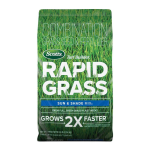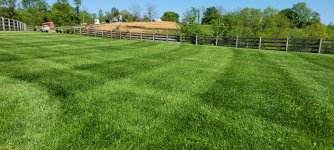I'm looking for some suggestions in getting my yard up to snuff. As a backstory- the house was built in 2023 so the grass for the lawn was put down that fall.
Presently I'm mostly covered but still "patchy" in some areas where I go down to bare soil & grass (can post pictures if needed).
In the past year I've placed at least four bags of "weed & feed" down (2 bags each time)...

Back in April I also "over seeded" and put down something like 60lbs of grass seed. Something like this- specific to the region I'm living in.

Yet I'm not having much luck filling in these patches this year and I'm at my wits end. I put down more grass seed than reasonable and no sooner that I do it the next week the birds are having an orgy in my yard eating it all up.
One thing I haven't done (due to expense & logistics) is to commit to aerating the lawn prior to over seeding.
So moving into Autumn- my question to the Hide is (1) is this battle 'normal' for a 'new' lawn? (2) am I better off just throwing in the proverbial towel and hiring a company like Tru-Green to essentially do what I've been doing but with a business "guarantee"?
Anyone else gone through this frustration? I'd love a perfect/lush lawn (don't get me wrong) but it isn't vanity I'm chasing after as much as it takes me 3 hours to mow the yard with a push mower and it's absolute "hell on wheels" pushing the mower through the dirt patches & against the natural inclines of the yard. One section of the yard I'm all but ready to throw in the towel and just plant a hedge of roses or some sort of crap before pushing the mower against that incline gives me a literal heart attack.
-LD
Presently I'm mostly covered but still "patchy" in some areas where I go down to bare soil & grass (can post pictures if needed).
In the past year I've placed at least four bags of "weed & feed" down (2 bags each time)...
Back in April I also "over seeded" and put down something like 60lbs of grass seed. Something like this- specific to the region I'm living in.
Yet I'm not having much luck filling in these patches this year and I'm at my wits end. I put down more grass seed than reasonable and no sooner that I do it the next week the birds are having an orgy in my yard eating it all up.
One thing I haven't done (due to expense & logistics) is to commit to aerating the lawn prior to over seeding.
So moving into Autumn- my question to the Hide is (1) is this battle 'normal' for a 'new' lawn? (2) am I better off just throwing in the proverbial towel and hiring a company like Tru-Green to essentially do what I've been doing but with a business "guarantee"?
Anyone else gone through this frustration? I'd love a perfect/lush lawn (don't get me wrong) but it isn't vanity I'm chasing after as much as it takes me 3 hours to mow the yard with a push mower and it's absolute "hell on wheels" pushing the mower through the dirt patches & against the natural inclines of the yard. One section of the yard I'm all but ready to throw in the towel and just plant a hedge of roses or some sort of crap before pushing the mower against that incline gives me a literal heart attack.
-LD




